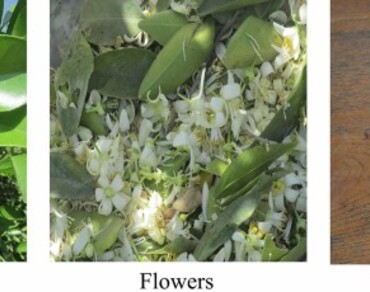Analyses of sweet lime essential oils (Citrus limettioides Tan) in relation to various planting sites in Egypt
Research Articles | Published: 05 August, 2023
First Page: 1434
Last Page: 1442
Views: 3128
Keywords: Leaves, Flowers, Peels, Citronellal, Nerol, Limonene
Abstract
Due to its biological qualities and safety for human consumption, sweet lime essential oil is employed in food and pharmaceutical industries. Geographical cultivation site is one strategy for modifying the composition of essential oils, which also broadens the range of their biological effects and enhances their natural sources. In the new reclamation zones, Egyptian government favours the cultivation of a variety of Citrus trees. Therefore, the objective of this study was to assess the leaf, flower and peel essential oils of sweet lime trees which are grown in different locations in order to determine the significance of growing sweet lime trees in those locations for utilizing them in essential oil production. From Egypt’s west, south and north, sweet lime leaves, flowers, and peels were gathered. Hydrodistillation was used to separate the essential oils from various organs at various locations, which were then subjected to gas chromatography and gas chromatography/mass spectroscopy analysis. As a result of varied agricultural sites, collected data indicated that different variations were found in the leaf, flower, and peel essential oils content. The main constituents in leaf, flower, and peel essential oils, respectively, were citronellal (53.8–54.1%), nerol (49.5–53.3%), and limonene (69.3–73.4%). Leaf and flower essential oils mostly contained oxygenated monoterpenes, while peel essential oil primarily contained monoterpene hydrocarbons. With samples collected from the south location, the highest values of the major components and fundamental chemical classes of the essential oil concentrations (%) were noted. In order to enhance the sources of essential oils as a natural product, sweet lime trees should be planted in recently reclaimed lands.

References
Angane M, Swift S, Huang K, Butts CA, Quek SY (2022) Essential oils and their Major Components: an updated review on antimicrobial activities, mechanism of action and their potential application in the Food Industry. Foods 11:464
Azavedo NR, Campos IFP, Ferreira HD, Portes TA, Santos SC, Seraphin JC, Paula JR, Ferri PH (2001) Chemical variability in the essential oil of Hyptis suaveolens. Phytochem 57:733–736
Berramdane T, Gourine N, Zitouni A, Bombarda I, Yousf M (2018) Essential oils composition of different Achillea santolina L. plant parts growing in Algeria. Orient Pharm Exp Med 18:265–269
Butnariu M, Sarac I (2018) Essential oils from plants. J Biotech Biomed Sci 4:35
Dodoš T, Janković S, Marin PD, Rajčević N (2021) Essential oil composition and micromorphological traits of Satureja montana L., S. subspicata Bartel ex Vis., and S. kitaibelii Wierzb. Ex Heuff. Plant Organs Plants 10:511
EL-Sharnoubry ME, Azab E, Alotaibi S, Saleh DI (2019) Influence of air temperature and soil moisture on growth and chemical composition of geranium plants. Pak J Bot 51:1–6
Figueiredo AC, Barroso JG, Pedro LG, Scheffer JC (2008) Factors affecting secondary metabolite production in plants: volatile components and essential oils. Flavour Fragr J 23:213–226
Giacomo A, Mincione B (1995) Olio essenziale di bergamotto. Laruffa, Reggio Calabria, Italy
Khalid AK (2021) Growth sites and their impacts on sour orange ʽCitrus aurantium (Tournef.)ʼ essential oil. Biocatal Agric Biotechnol 31:101909
Khalid AK (2022) Evaluation of leaf, flower and peel bitter orange essential oils and their constituents in response to various planting locations of Egypt. J Essent Oil-Bear Plants 25:208–218
Khalid AK, El-Gohary AE, Ahmed AMA (2018) Effect of the interaction between salicylic acid and geographical locations on grapefruit essential oil. J Essent Oil-Bear Plants 21:1594–1603
Khalid AK, El-Gohary AE, Ahmed AMA, Elkady F M A M, Talaat IM (2019) L-Tryptophan affects the essential oil of navel orange under various growing regions. Biocatal Agri Biotechnol 20:101181
Khalid AK, Ahmed AMA (2021) Effect of soil type on grapefruit and shaddock essential oils. J Soil Sci Plant Nutr 21:2048–2056
Khalid AK, El-Gohary AE, Ahmed AMA (2020) Effect of growing seasons on the leaf essential oil composition of Citrus species that are cultivated in Egypt. J Essent Oil Res 32:296–307
Kumar C, Singh D, Meena ML, Thirupathi N (2017) Minor fruits: Nutraceutical Importance and Cultivation: Sweet lime (Citrus limettioides). Jaya Publishing House, First Edition, ISBN, pp 978–9386110299
Mejri J, Abderrabba M, Mejri M (2010) Chemical composition of the essential oil of Ruta chalepensis L: influence of drying, hydro-distillation duration and plant parts. Indus Crops Prod 32:671–673
Mohamadi N, Rajaei P (2016) Effects of different ecological condition on the quality and quantity of essential oils of Artemisia persica Boiss populations from Kerman, Iran. J Ess Oil Bear Plant 19:200–207
Mohamed AA, Alotaibi BM (2023) Essential oils of some medicinal plants and their biological activities: a mini review. J Umm Al-Qura Univ Appll Sci 9:40–49
Nisar B, Sultan A, Rubab SL (2017) Comparison of medicinally important natural products versus synthetic drugs, a short commentary. Nat Prod Res 6:1000308
Oulebsir C, Mefti-Korteby H, Djazouli Z-E, Zebib B, Merah O (2022) Essential oil of Citrus aurantium L. Leaves: composition, antioxidant activity, elastase and collagenase inhibition. Agron 12:1466
Radulescu V, Popescu ML, Visan DC (2010) Chemical composition of the volatile oil from different plant parts of Anethum graveolens L. (Umbelliferae) cultivated in Romania. Farmacia 58:594–600
Satta M, Tuberoso CIG, Ngioni A, Pirisi FM, Cabras P (1999) Analysis of the essential oil of Helichrysum italicum G.Don. ssp. microphyllum (willd.) Nym. J Essent Oil Res 11:711–715
Sousa VI, Parente JF, Marques JF, Forte MA, Tavares CJ (2022) Microencapsulation of essential oils: a review. Polym (Basel) 14:1730
Author Information
Medicinal and Aromatic Plants Department, National Research Centre, Dokki, Egypt